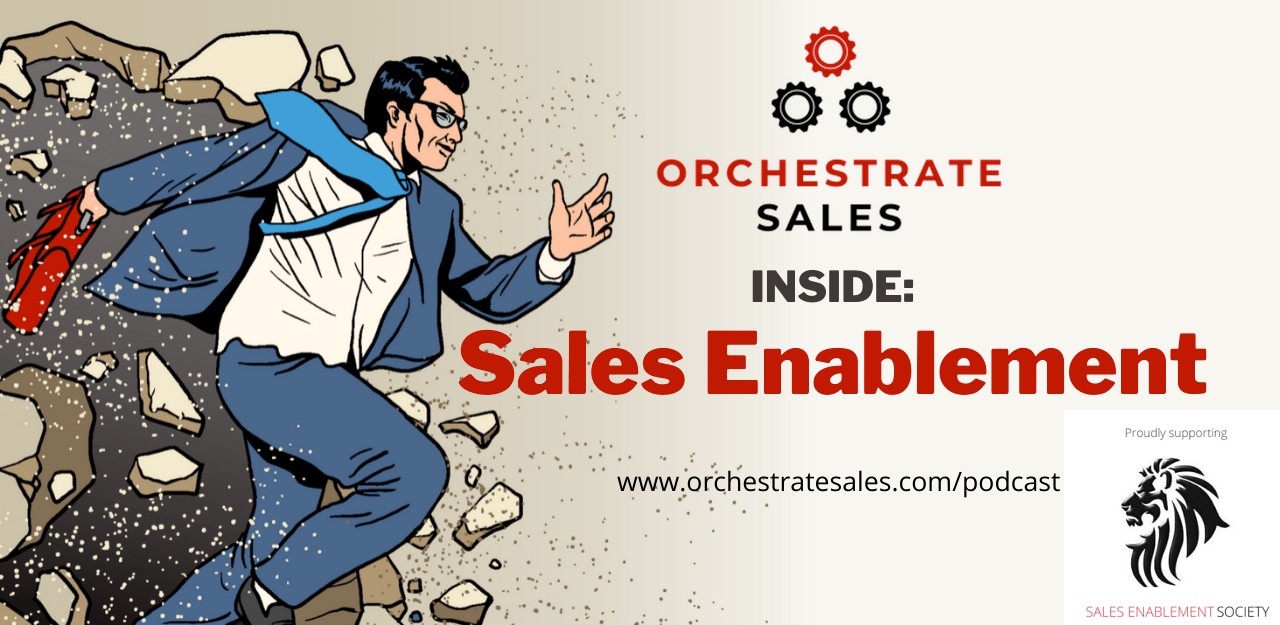Ep63 Helping Salespeople Communicate Value with Jen Burns
Welcome to Inside: Sales Enablement Episode 63
How do we make sales today and one of the things that we need to concentrate on is selling the value of what is actually value mean in the first place? No human being on the planet can live without water. But water is cheap, and prevalent, and inexpensive in most places. Whereas none of us need diamonds to survive. But diamonds are expensive. So what actually is value?
In this episode, the guys are joined by Jen Burns who runs sales enablement globally for IQVIA. The reason the concept is so important today is as we move into a digital into the digital economy where customer experience becomes so vital.
The key questions you must be able to help your sellers answer are: What actually is valuable? Is the product and service that you have, is that what is valuable? Or is it the outcome the customer achieves? Is that what's valuable. That's what we're talking about today.
AUDIO TRANSCRIPT:
Intro 00:02
Welcome to the inside sales enablement podcast. Where has the profession been? Where is it now? And where is it heading? What does it mean to you, your company, other functions? The market? Find out here. Join the founding father of the sales enablement profession Scott Santucci and Trailblazer Brian Lambert, as they take you behind the scenes of the birth of an industry, the inside sales enablement podcast starts now.
Scott Santucci 00:34
I'm Scott Santucci.
Brian Lambert 00:36
I'm Brian Lambert and we are the sales enablement insiders. Our podcast is for sales enablement leaders looking to elevate their function, expand their sphere of influence, and increase the span of control within their companies.
Scott Santucci 00:49
Together, Brian, I've worked on over 100 different kinds of sales enablement, initiatives as analysts, consultants or practitioners. We've learned the hard way, what works and maybe what's more important, what doesn't.
Brian Lambert 01:03
And our focus is on you, as a sales enablement leader and Orchestrator, sales enablement, leaders need to develop specific characteristics that we call Orchestration, operate in the blended domain of strategy and tactics, where you do both. Our goal on this podcast is to help you clarify what that looks like, provide examples that you can then take an action in your own company and give you confidence to engage up down and across the organization. And as usual, we have a centering story. So Scott, what do you have for us today?
Scott Santucci 01:34
So I'm going to lead with a quote, and I'm going to ask you to see if you can think place the quote and the time period.
Brian Lambert 01:42
Okay.
Scott Santucci 01:44
Here's the quote. Why is water that is vital for all life. cheap. And diamonds are so expensive.
Brian Lambert 01:56
Isn't this say? Something tells me that this is like the 1980s or something that a technology reference like a Steve Jobs keynote or something?
Scott Santucci 02:06
Close?
Brian Lambert 02:06
It is
Scott Santucci 02:07
very close. Yes. It's Aristotle. And it's about 300 BC. You were right. Close. My hopes
Brian Lambert 02:17
only to bash it upside that. Okay. Well, fine. Aristotle's a smart dude. I can get go for that.
Scott Santucci 02:22
I guess he's Steve Jobs. Yes. And essentially, he's got, you know, big thoughts.
Brian Lambert 02:27
And they probably are more like sandals.
Scott Santucci 02:29
There's the close part. So why are we talking about this and diamonds, around the time of Aristotle, many of the people many of the Greeks actually believe diamonds were literally tears of the gods. And between, then, and in the dark ages, many kings wore diamonds on their armor because it was a great, it was a great sign of health and virility and safety. And then in 1477, I guess that's the Renaissance time. maximillian, who at the time that this happened was the Archduke of the Habsburg Empire, babe later became the Holy Roman Emperor. So there's your Italian Kwazii connection there for you. Thanks. You're welcome. Nice pay out there. But this, this is pretty interesting. And 1477, he became the first person to actually propose to a woman using it using a diamond ring.
Brian Lambert 03:32
So it's his fault. I see.
Scott Santucci 03:34
It is his fault. So set so that then so we fast forward to 1938. And the reason 1938 is a is a good is a very important time is because at this point in time, that De Beers organization we all know about the beers cornered the diamond industry. And they commissioned a study because most of the diamond sales were happening in the United States at the time. And what's significant about 1938 Yes, it's during the Great Depression. And there was a big dip in diamond sales. They commissioned a study figured out that before 1938 you know, who they were trying to sell diamonds to directly to women. And what they found out is that they needed to sell diamonds to men, and specifically around this whole engagement ring phenomenon. So a woman named Dorothy diam did did a bunch of this research and when it first came out, they came out with a she's the one who came up with the Diamonds Are Forever program.
Brian Lambert 04:37
What's her name?
Scott Santucci 04:38
Dorothy was Dorothy Diane.
Brian Lambert 04:40
I thought I thought you said Dorothy diamond. I'm like what that did she changed her name. Okay.
Scott Santucci 04:46
Great. Yeah, actually credited as being one of the first people to do product placement so that
Brian Lambert 04:52
diamonds are forever. That's right.
Scott Santucci 04:55
So that's that became a slogan and wrote by By the 1950s diamond sales that drunk jumped at the time they were promoting one, one month salary for what you should pay for a ring that went so well they doubled it to two months. So those things are all going on. Now what's interesting then, and at the same time, in 1954, so think about alchemy, we've talked about alchemy, before people trying to make gold, and people have been trying to make diamonds or synthesize diamonds. And it wasn't it wasn't until 1954 that synthetic diamonds could be produced today, synthetic diamonds are its own industry and upon itself. So you have the regular mined diamonds that are used mostly or for gems. But then the synthetic diamonds are used for machine and cutting tools. They're used as thermal conductors, they're used as optical materials, electronics, and increasingly as gemstones and to bring this full circle. Part of the reason gemstones are becoming an option is because of environmental reasons and be poked, people are becoming more concerned with it. So for example, it takes about 250 tons of earth to produce one carat of diamonds, or also some of the poor working conditions are like, so what you have is, you know, coming back full step full circle to Aristotle. Why is water? vital? And why are diamonds so expensive? Well, there's a whole bunch of reasons for for diamonds, and a whole bunch of people have different value for it. So that's our centering story, full circle from Aristotle, the Aristotle between 300 some odd BC to 2020. And we've covered a lot of ground here.
Brian Lambert 06:56
Yeah, thanks. Great, great lesson, I guess. But I got to ask. So what? So what does this have to do with sales enablement?
Scott Santucci 07:05
So this has to do with sales enablement is the first part of that word is sales. How do we make sales today and one of the things that we need to concentrate on is selling the value of what is actually value mean in the first place? No human being on the planet can live without water. But water is cheap, and prevalent, and inexpensive in most places. Whereas none of us need diamonds to survive. But diamonds are expensive. So what actually is value. And the reason that that's so important today is as we move into a digital into the digital economy where customer experience becomes so important. What actually is valuable? Is the product and service that you have, is that what is valuable? Or is it the outcome the customer achieves? Is that what's valuable. So that's what we're talking about today.
Brian Lambert 08:02
Great. Well, we have with us to help us unpack this. And actually, we're using this and it this podcast in a in an interesting way. I think our listeners are gonna love to hear about this. We've got Jen burns with us, Scott, why don't you tell us a little bit about Jen and have her introduce herself. And then I'll come back at the end and recap what all this means to orchestrators.
Scott Santucci 08:22
Well, I'm super excited to introduce Jen for a variety reasons. So Jen and I go back aways. Jen actually was one of the participants, Brian, if you remember, the sales enablement society didn't start as a sales day was sorry, started as the washington dc local sales enablement. networking group, which I titled that was my baby.
Brian Lambert 08:47
That's why you're not in marketing.
Scott Santucci 08:48
That's true. I'm not in marketing. So Jen, Jen, join us there. Jen has been the been on the board of directors of the sale today and once it along the way. And now she runs sales enablement globally for a company called a cavia. So when they The third thing there for actually The fourth thing that I'm excited about is I'm really interested to see how Jen reacts to our centering story and connects the dots of what we're going to talk about. Jen, would you care to add some color about who you are and introduce yourself to inside our nation?
Jen Burns 09:23
Yeah, absolutely. Well, I'm kind of nervous about the pivot to the centering story, but we'll see what we can do. From that perspective. It was a great one. So see, I'm Jen burns, and Senior Director of Sales, global sales strategy, enablement training at IQ vs. Scott mentioned. And and I'm really excited to be part of this podcast and it I think it's been quite a number of years actually, since Scott, you and I have been on a webinar or podcast together and Brian similar to that, so. So it's great and a lot of has happened since then. Particularly since our early days. It days for sure. But um, you know, but I'm very excited to kind of get into this topic today, particularly because we're preparing for a keynote, this coming week at our global sales conference, which Scott is, is going to be leading, and I will be joining him in the discussion. So really important that we start to flesh this topic out and wanted to use this platform to really kind of think through some of the key issues to ensure that when we put it in front of the sales team, you know, it makes sense, and they can start leveraging some of these techniques. So it's really important, you know, for me, and for my organization to ensure that we continue to drive, you know, value to our customers, and very, very excited to discuss what that actually means today. So yeah, really great to be here, guys. Thanks for having me.
Scott Santucci 10:46
Oh, no problem. So in case you're wondering. And following along, let's make sure we're paying attention really clear, crystal clear, Jen is doing this podcast, because she's practicing. And she's practicing for a keynote presentation, that, well, we're gonna do, we're gonna do, we're gonna do together. So we're gonna do a keynote presentation for the sales kickoff that she's got in a few days. And we're practicing landing some of the concepts. So I just want to make sure that everybody recognizes that we all have to practice we all have to put ourselves in uncomfortable situations, we're asking our sales people to do it don't get outside of their comfort zone. I think this is a great opportunity to highlight that Jen's doing exactly that. So with that, having said that, let's talk about value. And why is this topic so important? Don't doesn't everybody know what value means? Gen y's, why is talking about values such a central theme for sales organizations in 2020?
Jen Burns 11:52
Yeah, so I think, you know, it reminds me back to the days when we were trying to put a definition behind sales enablement, right? It kind of means something different to every person. And, you know, I think for every sales enablement practitioner that's listening to this, or even a salesperson or marketing professional, it's the word value is a very nebulous term. And I think, you know, frankly, we throw it around, you know, in a way that it doesn't really clearly provide value. Right? So when we say we're value selling, or we're driving value to our customers, I think we really need to be careful about how we use that term, because what ends up happening is it doesn't carry meaning. And, you know, one of the reasons you know why Scott, I'm so excited to, you know, to be working with you, and growth enablement and trying to, you know, work through what, what the definition of value really means to to our sales, sales organization, so we can continue can continue to drive growth, it's really thinking about, you know, what it means to the customer, because I think we all want to define it from our lens. But really, you know, the value is what the customer thinks it is not what we think it is. And so there's a lot of, you know, ways that I think we can get to that answer. And so really excited to, you know, to start working through, you know, one, how we do that, and to how we communicate it to sales so that they can articulate it in a much stronger way to our customers,
Scott Santucci 13:22
right. And one of the things that where this problems begins, or starts, really comes down to as businesses, we tend to go to market. And when we go to market, we think, let's make a list of all the different products that we've got our capabilities that we've got. Now let's compare those capabilities, and how do we compare those capabilities, either by the speeds and feeds that we can prove and demonstrate or what we can demo, or by how we compare against our competitors. And I think the observation that we're on Jen and love, you get some add some more clarity about that, is, as we build more and more capabilities, one, we can't communicate all that stuff to people, it becomes overwhelming. And to from a customer standpoint, one of the challenges is how are we going to get everybody who is who's involved in that on the same page? And how are we going to turn those capabilities into value for us? So are you seeing similar similar situations? And how do you go about preparing the right kinds of materials to have a value driven conversation?
Jen Burns 14:32
Yeah, so let's, let's unpack this a little bit, because I'll give you my perspective. And then actually, I'd like to get yours right on, you know, potentially a different direction. so well done in a very, in a very simple way, right? The way that that you know, and I and I will come out and be transparent and say that this is how I typically view value right and i think others do as well is that when we're trying Trying to prepare our sales organization to sell more effectively and have better deeper conversations with buyers, we often anchor that conversation to what our solutions are going to drive. Right? So, you know, what can we increase or decrease? Can we drive revenue growth rate, all of the key buzzwords that everybody uses in their marketing materials or sales conversations. And you know, of course, that's all talking about product. And while we absolutely want to share those things, and they're very meaningful at different parts of the conversation, and conversations that we have with buyers and other key stakeholders, I don't think they're the things that really set us up for a good consultative relationship so that we can help our buyers understand, you know, what is that value that that they're looking for? Right, because we think myopically that it's directly, you know, related to our product and what it can do versus what actually is going on with an organization that directly impacts that definition to them. So I would actually turn it back to you, Scott, and just get your thoughts on, you know, one is, is the pattern kind of that you see, directly correlating value to product versus, you know, people actually digging into the value that the customer believes that they're trying to drive, which may be influenced by things going on in their environment? And then how do we actually think differently about that? As we're crafting, you know, our resources and tools for sales? Because it's a very difficult thing for me to kind of get my hands around? Yes.
Scott Santucci 16:35
So Jen is leading with all of you guys. She has a more refined view than what she's what she's sharing. The Jen, you and I both have had experience talking about this concept of prototypes. And it's been really the width inside your company. I think that's really where where things start, is that we've just got so much muscle memory, about wanting to talk about what we've got, that we're losing sight of what's valuable for customers. That's one point. The second point is, I think it's really difficult when we so let's say that Brian, were a real estate agent and genuine I had a business partnership where we're looking to buy some real estate. Brian referred to us as buyers, we're going to be put off because we haven't bought anything yet. So I think another another challenge is let's, let's move off of thinking about the people that we're trying to sell to as buyers because it desensitizes it, we treat them like there's some formulaic thing out there just waiting. They have all this demand for whatever our product and services, but the reality is they don't. The reality is to create demand with them. And maybe we don't treat them as buyers, we treat them actually as customers and human beings.
Jen Burns 18:06
Yeah, no, that's that's a fair point, honestly, and, and frankly, if we were doing our jobs well, as salespeople, you know, we want them to recognize, you know, in many cases, problems they may not realize exists. So if there's no problems in their mind, they're not buyers. That's right. So it actually makes sense to say it that way, I agree with you.
Scott Santucci 18:26
So when we when we when we unpack that, then what makes it be makes it very difficult is we're in the b2b world. So in your case, Janet acuvue, you sell to pharmaceutical companies. So pharmaceutical companies are multinational, large, complex entities and word that's what we're technically selling to. However, we're also selling to human beings as well. And I think this is where things become challenging is to not confront the complexities that exist in a b2b organization to start off with. So one of the things that we have developed is a, what we call a value equation. And there's three simple parts to it, there is the impact that we can bring to bear to the company that you have to co create or agree on. There...




